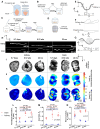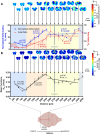Alteration of mechanical stresses in the murine brain by age and hemorrhagic stroke
- PMID: 38659974
- PMCID: PMC11042661
- DOI: 10.1093/pnasnexus/pgae141
Alteration of mechanical stresses in the murine brain by age and hemorrhagic stroke
Abstract
Residual mechanical stresses, also known as solid stresses, emerge during rapid differential growth or remodeling of tissues, as observed in morphogenesis and tumor growth. While residual stresses typically dissipate in most healthy adult organs, as the growth rate decreases, high residual stresses have been reported in mature, healthy brains. However, the origins and consequences of residual mechanical stresses in the brain across health, aging, and disease remain poorly understood. Here, we utilized and validated a previously developed method to map residual mechanical stresses in the brains of mice across three age groups: 5-7 days, 8-12 weeks, and 22 months. We found that residual solid stress rapidly increases from 5-7 days to 8-12 weeks and remains high in mature 22 months mice brains. Three-dimensional mapping revealed unevenly distributed residual stresses from the anterior to posterior coronal brain sections. Since the brain is rich in negatively charged hyaluronic acid, we evaluated the contribution of charged extracellular matrix (ECM) constituents in maintaining solid stress levels. We found that lower ionic strength leads to elevated solid stresses, consistent with its unshielding effect and the subsequent expansion of charged ECM components. Lastly, we demonstrated that hemorrhagic stroke, accompanied by loss of cellular density, resulted in decreased residual stress in the murine brain. Our findings contribute to a better understanding of spatiotemporal alterations of residual solid stresses in healthy and diseased brains, a crucial step toward uncovering the biological and immunological consequences of this understudied mechanical phenotype in the brain.
Keywords: age-related alteration; hemorrhagic stroke; mouse brain; residual solid stress.
© The Author(s) 2024. Published by Oxford University Press on behalf of National Academy of Sciences.
Figures





References
Grants and funding
LinkOut - more resources
Full Text Sources
Molecular Biology Databases

